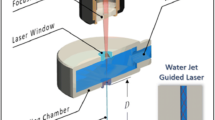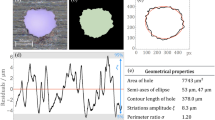Abstract
The criterion for ensuring formation of a through hole is an important aspect of laser drilling. Close observation of the process has indicated that drilling of the substrate is achieved in six successive microstages. The stages have been time resolved and the behaviour of laser induced plasma (LIP) during the microstages of drilling has been carefully examined. The LIP behaviour during the percussion laser drilling has been explained with the help of the contemporary understanding of plasma. This paper proposes a drilling completion criterion that is based on the behaviour of LIP during laser percussion drilling of SUPERNI 263A with a Nd-doped yttrium aluminium garnet laser. The completion of formation of a hole is marked by the momentarily increased luminescence of the plasma plume emanating from the laser beam exit side of the workpiece during drilling. The criterion has been experimentally verified. The criterion is versatile and can help in augmenting productivity during manufacturing.
Similar content being viewed by others
References
Pandey PC, Shan HS (1980) Modern machining processes. Tata McGraw-Hill, New Delhi, India
Dausinger F (1999) Precise drilling with short-pulsed lasers. Proc SPIE High Power Lasers in Manufacturing, Osaka, Japan 3888:180–198
Knowles MRH Bell AI, Rutterford G, Booth H, Foster-Turner G, Kearsely AJ (1999) Applications of high-power visible and UV lasers in manufacturing. Proc, SPIE High Power Lasers in Manufacturing, Osaka, Japan, 3888:210–216
Ferguson IW, Morrison MJ, Vanderwert TL Drilling holes in turbine engines. Ind Laser Solut 18(8):13–16
Pandey ND, Bharti A, Shan HS (2002) Fundamentals of laser drilling. Proc, Workshop on Applications of Lasers in Mechanical Industries (WALMI 2002), Kolkata, India, 22–24 February 2002, pp 56–72
van Dijk MHH (1994) Laser drilling of gas turbine components. Ind Laser Rev 9(10):7–12
Herriot DR (1969) Laser and light. Freeman, New York
Armon E, Hill M, Spalding IJ, Zurin Y (1989) Metal drilling with a CO2 laser beam II. Analysis of aluminum drilling experiments. J Appl Phys 65(12):5003–5006
Patel RS (1989) The role of an assist gas during laser-metal interaction. Dissertation, University of Illinois at Urbana-Champaign
Tam SC, Yeo CY, Jana S, Lau MWS, Lim LEN, Yang LJ, Noor YM (1993) Optimization of laser deep-hole drilling of Inconel 718 using the Taguchi method. J Mater Process Technol 37:741–757
Yilbas BS (1995) Study of liquid and vapor ejection processes during laser drilling of metals. J Laser Appl 7: 147–152
Low DKY, Li L, Corfe AG (2000) The influence of assist gas on the mechanism of material ejection and removal during laser percussion drilling. Proc Instituion of Mechanical Engineers, Part B. J Eng Manuf 214(B):521–527
Low DKY, Li L, Byrd PJ (2000) The effect of process parameters on spatter deposition in laser percussion drilling. Optics Laser Technol 32:347–354
Low DKY, Li L, Byrd PJ (2001) The influence of temporal pulse train modulation during laser percussion drilling. Opt Lasers Eng 35:149–164
Kamalu J, Byrd P, Pitman A (2002) Variable angle laser drilling of themal barrier coated Nimonic. J Mater Process Technol 122:355–362
Sun A, Asibu EK, Gartner M (1999) Sensor systems for real time monitoring of laser weld quality. J Laser Appl 11(4):153–168
French PW, Hand DP, Peters C, Shannon GJ, Byrd P, Steen WM (1999) Investigations of the Nd: YAG laser percussion drilling process using high speed filming. CLF Annu Rep, pp 162–166
Strgar S, Mozina J (2002) An optodynamic determination of the depth of laser-drilled holes by the simultaneous detection of ultrasonic waves in air and in the workpiece. Ultrasonics 40:791–795
Haran FM, Hand DP, Ebrahim SM, Peters C, Jones JDC (1997) Optical signal oscillations in laser keyhole welding and potential application to lap welding. Meas Sci Technol 8:627–633
Hand DP, Fox MDT, Haran FM, Peters C, Morgan SA, McLean MA, Steen WM, Jones JDC (2000) Optical focus control system for laser welding and direct casting. Opt Lasers Eng 34:415–427
Tonshoff HK, Ostendorf A, Korber K, Hillers O (2001) Principles of reference-free process monitoring for laser material processing based on a multiple sensor system. Proc, International Congress on Applications of Lasers & Electro-Optics (ICALEO 2001). Laser Inst Am 92/93:1033–1042
Rockstroh TJ, Scheidt D, Ash C (2002) Advances in laser drilling of turbine aerofoils. Ind Laser Solut 17(8):15–21
Hughes TP (1975) Plasmas and laser light. Hilger, London, UK
Ready JF (1965) Effects due to absorption of laser radiation. J Appl Phys 36(2):462–468
Carslaw JE, Jaeger JC (1959) Conduction of heat in solids. Oxford University Press, UK
Steen WM (1991) Laser material processing. Springer, Berlin Heidelberg New York
Duley WW (1976) CO2 Lasers. Academic, London, UK
von Allmen M, Blatter A (1995) Laser beam interactions with materials. Springer, Berlin Heidelberg New York
Chan CL, Mazumder J (1987) One-dimensional steady-state model for damage by vaporization and liquid expulsion due to laser-material interaction. J Appl Phys 62(11):4579–4586
Matsunawa A, Yoshida H, Katayama S (1984) Beam-plume interaction in pulsed YAG laser processing. Proc, International Congress on Applications of Lasers and Electro-Optics (ICALEO’84). Laser Inst Am 44:35–42
Srikanth S, Kar A (1997) Modelling of dynamical processes in laser induced plasma. Proc, International Congress on Applications of Lasers and Electro-Optics (ICALEO’97). Laser Inst Am 83:179–188
Gray DE (ed) (1972) American institute of physics handbook, McGraw-Hill, New York
Author information
Authors and Affiliations
Corresponding author
Rights and permissions
About this article
Cite this article
Pandey, N.D., Shan, H.S. & Bharti, A. Percussion drilling with laser: hole completion criterion. Int J Adv Manuf Technol 28, 863–868 (2006). https://doi.org/10.1007/s00170-004-2442-7
Received:
Accepted:
Issue Date:
DOI: https://doi.org/10.1007/s00170-004-2442-7




